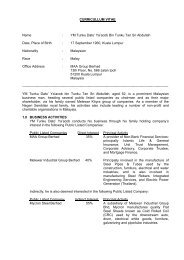Annual Report (Complete) - MYCRON Steel Berhad
Annual Report (Complete) - MYCRON Steel Berhad
Annual Report (Complete) - MYCRON Steel Berhad
You also want an ePaper? Increase the reach of your titles
YUMPU automatically turns print PDFs into web optimized ePapers that Google loves.
Notes to the Financial Statements<br />
30 June 2010<br />
(continued)<br />
2. SUMMARY OF SIGNIFICANT ACCOUNTING POLICIES (continued)<br />
(i)<br />
Share capital (continued)<br />
Interim dividends are recognised as liabilities when declared before the balance sheet date. Final dividends are accounted<br />
for when it had been approved by the Company’s shareholders.<br />
(j)<br />
Treasury shares<br />
When the Company or its subsidiaries purchases the Company’s equity share capital, the consideration paid, including any<br />
directly attributable incremental external costs, net of tax, is deducted from total equity as treasury shares until they are<br />
cancelled, reissued or disposed off. Where such shares are subsequently sold or reissued, any consideration received, net<br />
of any directly attributable incremental external costs and the related tax effects, is included in total equity.<br />
(k)<br />
Impairment of non-financial assets<br />
Assets that have an indefinite useful life are not subject to amortisation and are tested annually for impairment. Assets that<br />
are subject to amortisation are reviewed for impairment whenever events or changes in circumstances indicate that the<br />
carrying amount may not be recoverable. An impairment loss is recognised for the amount by which the asset’s carrying<br />
amount exceeds its recoverable amount. The recoverable amount is the higher of an asset’s fair value less costs to sell and<br />
value-in-use.<br />
For the purposes of assessing impairment, assets are grouped at the lowest levels for which there are separately identifiable<br />
cash flows (cash-generating units). Non-financial assets other than goodwill that suffered impairment are reviewed for<br />
possible reversal of the impairment at each reporting date.<br />
The impairment loss is charged to the income statement unless it reverses a previous revaluation in which case it is charged<br />
to the revaluation surplus. Impairment loss on goodwill is not reversed. In respect of other assets, any subsequent increase<br />
in recoverable amount is recognised in the income statement unless it reverses an impairment loss on a revalued asset in<br />
which case it is taken to revaluation surplus.<br />
(l)<br />
Foreign currencies<br />
(i)<br />
Functional and presentation currency<br />
The management has determined the currency of the primary economic environment in which the Group operates<br />
i.e. functional currency, to be Ringgit Malaysia. Sales price and major costs of providing goods and services including<br />
major operating expenses are primarily influenced by fluctuations in Ringgit Malaysia. The financial statements are<br />
presented in Ringgit Malaysia, which is the Group’s functional and presentation currency.<br />
(ii)<br />
Transactions and balances<br />
Transactions in foreign currencies are translated into Ringgit Malaysia at the rates of exchange prevailing at the<br />
dates of the transactions. Monetary assets and liabilities denominated in foreign currencies at the balance sheet<br />
date are translated to Ringgit Malaysia at the closing rates. Foreign exchange differences arising on the settlement<br />
of such transactions are recognised in the income statement. Non-monetary assets and liabilities denominated in<br />
foreign currencies are translated to Ringgit Malaysia at rates of exchange prevailing at the date of transactions.<br />
Changes in the fair value of monetary securities denominated in foreign currency classified as available-for-sale are<br />
analysed between translation differences resulting from changes in the amortised cost of the security, and other<br />
changes in the carrying amount of the security. Translation differences related to changes in amortised cost are<br />
recognised in income statement and other changes in carrying amount are recognised in equity.<br />
Translation differences on non-monetary financial assets and liabilities are reported as part of the fair value gain or<br />
loss. Translation differences on nonmonetary financial assets and liabilities such as equities held at fair value through<br />
profit or loss are recognised in income statement as part of the fair value gain or loss. Translation differences on<br />
non-monetary financial assets such as equities classified as available-for-sale are included in the available-for-sale<br />
reserve in equity.<br />
(m) Provisions<br />
Provisions are recognised when the Group has a present legal or constructive obligation as a result of past events; when it is<br />
probable that an outflow of resources will be required to settle the obligation; and the amount has been reliably estimated.<br />
Provisions are not recognised for future operating losses.<br />
Where there are a number of similar obligations, the likelihood that an outflow will be required in settlement is determined<br />
by considering the class of obligations as a whole. A provision is recognised even if the likelihood of an outflow with respect<br />
to any one item included in the same class of obligations may be small.<br />
pg 59 | Mycron <strong>Steel</strong> <strong>Berhad</strong>











